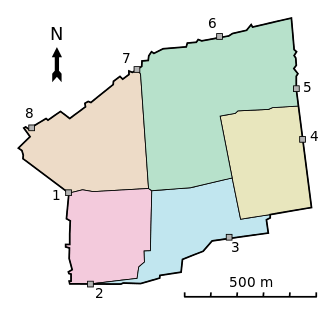Gates of the Old City of Jerusalem
The article lists the Gates of the Old City of Jerusalem, not including the Gates of the Temple Mount. The gates are visible on most old maps of Jerusalem over the last 1,500 years.
During different periods, the city walls followed different outlines and had a varying number of gates. During the era of the crusader Kingdom of Jerusalem for instance, Jerusalem had four gates, one on each side. The current walls were built by Suleiman the Magnificent, who provided them with six gates; several older gates, which had been walled up before the arrival of the Ottomans, were left as they were. As to the previously sealed Golden Gate, Suleiman at first opened and rebuilt it, but then walled it up again as well. The number of operational gates increased to seven after the addition of the New Gate in 1887; a smaller eighth one, popularly known as the Tanners' Gate, has been opened for visitors after being discovered and unsealed during excavations in the 1990s. The sealed historic gates comprise four that are at least partially preserved (the double Golden Gate in the eastern wall, and the Single, Triple, and Double Gates in the southern wall), with several other gates discovered by archaeologists of which only traces remain (the so-called Gate of the Essenes on Mount Zion, the gate of Herod's royal palace south of the citadel, and the vague remains of what 19th-century explorers identified as the Gate of the Funerals (Bab al-Jana'iz) or of al-Buraq (Bab al-Buraq) south of the Golden Gate[1]).
Until 1887, each gate was closed before sunset and opened at sunrise. As indicated by the chart below, these gates have been known by a variety of names used in different historical periods and by different communities.
References
- Gülru Necipoğlu (2008). "The Dome of the Rock as a palimpsest: 'Abd al-Malik's grand narrative and Sultan Süleyman's glosses" (PDF). Muqarnas: An Annual on the Visual Culture of the Islamic. Leiden: Brill. 25: 20–21. ISBN 9789004173279. Archived from the original (PDF) on 27 September 2015. Retrieved 26 September 2015.
- "The Function and Plan of the 'Palaces'". The Jerusalem Archaeological Park – Davidson Center. Archived from the original on 4 March 2016. Retrieved 8 January 2016.
- Meir Ben-Dov (1987). The Excavation Gate (18). The Ophel archaeological garden. Jerusalem: East Jerusalem Development Ltd. p. 20.
Thus for all intents and purposes, a ninth gate has been opened in the walls of Jerusalem.
